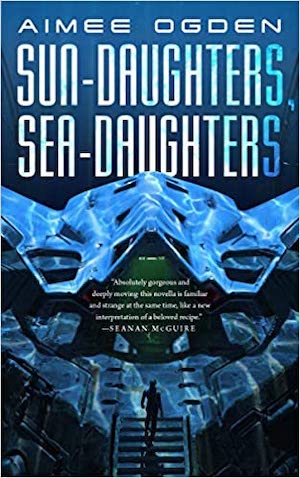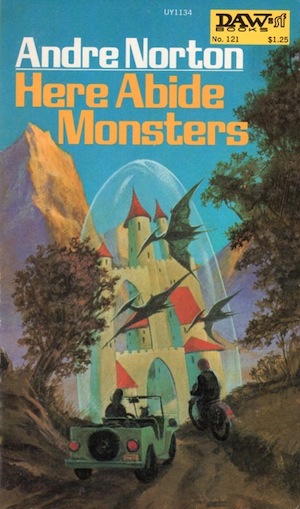Plotting was Andre Norton’s main strength as a writer. Her novels are plot-driven, to the point that characters frequently do things “somehow” or “without thinking” or “something made them do it.” Their own volition is subordinate to the pressure of the plot.
Norton was a master of rapid pacing. Her novels are full of breakneck action and unstoppable adventure. Characters race from peril to peril with little or no pause in between–and then, almost without fail, come to an abrupt halt. Endings in Norton novels waste no time at all, either in wrapping up the action or in throwing characters into one another’s arms. More often than not, everything rolls itself up into a tight ball in a page, and sometimes not much more than a paragraph.
For the most part, Norton’s strengths overcome her great weakness, which is character development. She created a number of memorable if not deep or complex characters. Some of my favorites include Maelen the Moonsinger, Murdoc Jern and his alien companion Eet, and the tormented but irresistibly appealing Kerovan. These and others like them are lightly sketched in, but the lines are clear enough that the reader can fill in the rest.
Sometimes Norton’s strengths weren’t enough to overcome her weaknesses. Here Abide Monsters tries to be a number of things at once. It wants to tell the story of a character with a complicated inner life and a difficult family, who is trying to find his way first in his own world and then in a world full of magic and monsters. At the same time it tries to build that world in a number of different directions: as alternate world, as parallel world, as manifestation of numerous myths and legends. With, as always, a strong strain of action-adventure.
Nick is a young adult, college age or so, but he’s still dependent on his father and his horrible, controlling stepmother. As the story begins, he’s riding on his motorcycle toward the family cabin for a weekend retreat, hoping to get his head together and figure out how to deal with his family situation. When he stops for supplies at the general store near the cabin—complete with awesome bodega cat—he finds himself enlisted to guide another traveler, a young woman of about his own age, to another cabin where she is also planning a weekend getaway. Nick’s purchases are basic staples, but Linda is buying a whole Jeep-load of soft drinks and junk food, apparently for a party.
The complication here is that Linda’s host lives down a road with an evil reputation. People who travel on it have been known to disappear without a trace. Locals avoid it, and Nick is planning to, but the only access to Linda’s destination is via that road. Nick lets himself be talked into braving it anyway, with predictable results.
Buy the Book


Sun-Daughters, Sea-Daughters
Nick and Linda and her dog, Lung, crash through a sudden mist into another world, a world of ancient forests and—as they discover almost immediately—mythical beasts. The first one they encounter is a unicorn. Others follow, along with a whole bestiary of heraldic monsters and a small population of faery folk of various descriptions. Most notable among those is a being called the Herald, who looks like a walking, talking, three-dimensional playing card.
There are also, jarringly, fleets of flying saucers that do their best to destroy the Herald and his companions with death rays when they’re not abducting roving gangs of humans from all eras and regions of Earth: Mongols, modern Chinese soldiers, Roman legionaries, Western medieval types of various sorts, and most relevant to Nick and Linda’s interests, a band of British refugees from the Second World War.
These Brits from the Blitz are well-meaning and intrepid, and they take the Americans in and help them navigate the dangers of this strange and perilous world. They’ve been here for four years by their reckoning, but over forty by Nick’s—he actually comes from Norton’s own future, from the year 1985; the novel was published in 1973. As they travel from refuge to bolthole to fortified retreat, they teach Nick everything they know about the world, and warn him most particularly about the Herald and the shining cities from which he emerges. He will make Nick an offer of safety, they say, but if he accepts it, he’ll no longer be human.
Proof of this is one of their number who accepted the offer, whose lover is still with them, embittered and grief-stricken. Rita has indeed been changed, and no longer either looks or acts human, but she keeps what she calls a “heart-tie” with her former companions.
Nick isn’t so sure that this is a bad thing. While he rambles around the countryside, trying to escape being abducted by the saucer people or killed by hostile natives or human refugees, he wonders about the shining cities and thinks that maybe the Herald’s bargain might be worth taking.
Eventually he is captured by a gang of perfectly horrible medieval humans led by a fanatical monk and a leeringly evil young noblewoman. Before they can seriously get down to the business of torturing him as a “devil,” they are attacked and abducted in their own turn by an army of actual devils. Nick is left alone, bound and unable to free himself, until the Herald appears and gives him a clue as to how to do that.
This involves awakening uncanny mind powers to draw a knife to him and cut his bonds. These powers also enable him to create illusions that might let him infiltrate a city without accepting the Herald’s offer. But that doesn’t work as he intended: he’s instantly spotted, and it’s Rita who guides him back out and tells him what he’s doing is not a good thing.
There’s a lot of wandering around and evading enemies of all species, and an eventual repeat of the infiltration attempt, but this time using illusion to steal a saucer and rescue some of the Brits who have been abducted. Maybe it’s bad, Nick tells himself, but he has to do it in order to save his friends. Which he does, eventually, while also blowing up the saucer people’s evil energy pole which they are using to open portals to the forces of Darkness. In doing this, he quite inadvertently saves the world for the good guys, including the Herald and the very helpful Rita. And now he’s a part of this world, since there’s no hope of going back to his own, and anyway he isn’t really sure he wants to.
If this sounds like a bit of mess, it reads like one, too. There are some lovely individual elements. The animal companions turn out to be fully as intelligent and capable as the humans. Lung the Pekingese was included in the novel, according to the author’s note, at the request of a friend. Jeremiah the cat is a classic Norton cat-character; so is the bodega cat, who gets a great buildup but never shows up again after Nick leaves the general store.
The world in which Nick finds himself is based on a range of Celtic myths and legends, notably Avalon, but it feels as if Norton threw anything she could think of at it, from flying saucers to Roman legions. There’s no coherence to it, and not much purpose apart from “they all fell through portals but we don’t know what those portals were or why or how they formed, and also, Darkness and monsters.” Nor do the saucer people make a lot of sense; for all the talk of Darkness and cyclic invasions of evil, they’re the main antagonists. They’re trying to destroy the world, but it’s not clear why they’re doing that, or why they keep abducting human refugees, or really what their point is.
There are a lot of missed opportunities. Nick’s attempt to infiltrate a city fails, but he never sees what’s in it, and he doesn’t really learn anything from it. He’s constantly doubting the Brits’ assessment of the Herald, and the Herald keeps dropping hints and getting him out of tight spots, but he never really has to make the choice he keeps being set up for. It’s always just out of reach.
It’s as if, every time the plot might start to delve deeper into the hows and whys of one of its elements, it backs off. Norton could do so much more with Nick as a character, with his British allies (who read like the cast of a classic cozy mystery: the Vicar, the stalwart housekeeper with the witchy background, the intrepid lady aristocrat), and with their very ambiguous relationship with the Herald and his people. I kept waiting for the action to take us to a city, to show us the people, to introduce us to the King, but it never happens. Instead we get yet another chase, yet another capture, yet another trek through hostile country. And then there are the saucer people, who could have been fascinating, but again, she won’t give them the space to develop.
In the end, this is a book that can’t make up its mind what it’s about. It’s got a mishmash of elements that Norton has used before and will use again, but none of them really jells. It could have been a genre-bending tour de force along the lines of her Witch World books. Instead it just sort of runs around in circles.
Next time I’ll have a go at Yurth Burden. We’ll see if she was more at ease with that combination of elements than she was with this one.
Judith Tarr’s first novel, The Isle of Glass, appeared in 1985. Since then she’s written novels and shorter works of historical fiction and historical fantasy and epic fantasy and space opera and contemporary fantasy, many of which have been reborn as ebooks. She has even written a primer for writers: Writing Horses: The Fine Art of Getting It Right. She has won the Crawford Award, and been a finalist for the World Fantasy Award and the Locus Award. She lives in Arizona with an assortment of cats, a blue-eyed dog, and a herd of Lipizzan horses.











This is what I call kitchen sink worldbuilding. Everything including the kitchen sink is thrown in to the point of silliness.
I wouldn’t call Norton’s plotting her strong point. Plot is a character moving forward through a string of cause and effect toward a goal. Norton’s plots consisted of randomly using favorite tropes to keep things moving along while the character flails about with little control.
@1 My definition of plot is different than yours.. This article proceeds on that basis.
I read that book as a kid. I also read it very quickly because we were about to move and I needed to get it back to the school library. St the time, I thought the problem was that I tore through it pretty quickly. After reading this review, I’m thinking it might have been the book. Still think it’s a great title, and I think it would be a fun world to set other stories in (unicorns AND flying saucers? What more could a kid want?)
I remember being intrigued by this one when I was a kid. Maybe I was 12 or 13 when I tried to read it.
It utterly didn’t work for me. I had read and enjoyed “Dragon Magic” and a couple of other Norton novels, but this one made me lose interest in Norton.
This story fits a bit more with Knave of Dreams, Wraiths of Time, Wheel of Stars, and maybe Garan the Eternal than the sci-fi novel it’s paired with in that omnibus. I guess the publisher had some odds and ends of Andre books to pair up and just lumped them together. They’re a bit more like the Books of Magic novels but for an older audience.